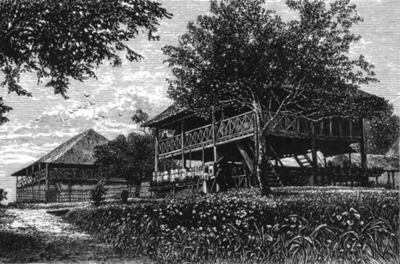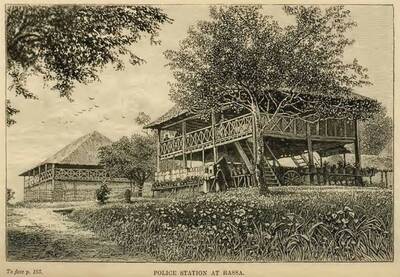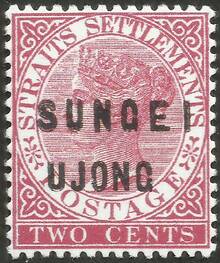Jadual Kandungan
Rasah
Dirujuk oleh
Perihal
Rasah ialah sebuah pekan perlombongan berhampiran bandar Sungai Ujong (dibuka tahun 1870-an, kemudiannya dinamakan Seremban): “The town of Sungai Ujong came into existence with the discovery of tin ore in the 1870s like most major towns in Peninsular Malaysia. The discovery of tin in a nearby area called Rasah, saw an influx of Arab, Malay and Chinese immigrants to work on the mines and trade there. Most of the local Malays were farmers. Renamed Seremban, the town flourished not only as a mining area but also a business center. The Linggi River served as the sole outlet to ferry tin and supplies in and out of the town. Revenue came not only from tin trade but also from the large amount of taxes collected, much to the displeasure of the traders and the British colonialists at the neighboring port of Malacca.” (Mark Joseph Jochim, APRIL 2, 2018: |"Sungei Ujong #15 (1884)").
1640-an: Bendahara Sekudai
“The Dutch had been in more or less friendly relations with Johore for nearly 40 years before the capture of Malacca in 1641. Their policy was apparently to encourage the rulers of Johore re-assert their overlordship over the territories north and east of Malacca. This was the most economical way of bringing these territories under indirect Dutch control for the maintenance of law and order and the promotion of the tin trade. Direct dealings with the hinterland led to trouble in 1643 in Rembau and so perhaps the Dutch sent for an envoy from Johore. The Sultan of Johore in correspondence at this time is at pains to attribute to his Bendahara all responsibility for Negri Sembilan; since historically the inhabitants were his tenants. Schouten says that Rembau paid tribute to the Bendahara, and it is likely that the other states in Negri Sembilan did so also. The Bendahara of this time was almost certainly Bendahara Sekudai. The tradition relates that he came on a visit to Negri Sembilan and Pahang. This fits very well with the history of the time, and the visit has been dated in 1644. In Sungei Ujong Bendahara Sekudai probably found a trading and mining centre at Rasah and Rahang, at which he stayed, with the Malacca family at Pantai under the Penghulu Mentri and another branch lower down the Linggi under the Shahbandar. These titles Bendahara Sekudai confirmed or, if they were then in abeyance, revived. It would be consistent with the presumed purpose of his visit that he should appoint or confirm a territorial chief and a collector of customs to whom Johore could look for the execution of its orders and the collection of its revenues. The recipients of the titles were glad enough to fortify their position vis-a-vis the Sumatran immigrants by obtaining recognition from the premier Malay state of the day. … The second object of Bendahara Sekudai's visit in 1644 may have been to create good relations between the Dutch and the people of Negri Sembilan.” (J. M. Gullick @ Journal of the Malayan Branch of the Royal Asiatic Society Vol. 22, No. 2 (148), Sungei Ujong (May 1949), pp. 1-69: "Sungei Ujong", m.s.11-12,14).
1820-an: Pelombong dari Cina
“In the early nineteenth century the production of tin in Sungei Ujong increased owing to the influx of Chinese miners. There had been Malay mining on a commercial scale for centuries past. Batak and Rawa serfs from Sumatra were brought in as mining labour. But the Chinese miners were much more industrious and skilful than the Malays. Hence they were allowed to take up the infields and mine them in consideration of a lump sum or a percentage to the Malay chief or landowner. In 1828 there were nearly 1,000 miners in the tinfields around Rasah, but shortly afterwards there was trouble between Malays and Chinese, in consequence of which the majority of the Chinese fled to Selangor.” (J. M. Gullick @ Journal of the Malayan Branch of the Royal Asiatic Society Vol. 22, No. 2 (148), Sungei Ujong (May 1949), pp. 1-69: "Sungei Ujong", m.s.19).
“Before the days of towns Rasah, just south of Seremban, was the commercial centre of Sungei Ujong. There was a permanent fair at Rasah to which traders brought their goods by boat up the Linggi. River traffic stopped at Jeboi, three miles above Rasah, and here the tin was brought down to be loaded for shipment to Linggi in exchange for rice, opium, salt, tobacco, cloth, oil and shell for making lime. Rasah itself was a tin mining centre to which the Chinese came in strength from the early nineteenth century onwards. A small colony of Arabs settled here too, and in time became absorbed in the Malay community. Rasah was the domain of the Dato' Shahbandar who became rich with the dues of market and river.” (J. M. Gullick @ Journal of the Malayan Branch of the Royal Asiatic Society Vol. 22, No. 2 (148), Sungei Ujong (May 1949), pp. 1-69: "Sungei Ujong", m.s.5).


Kiri: Balai Polis Rasah, 1883: “POLICE STATION AT RASSA” (Isabella Lucy Bird, 1883: |"The Golden Chersonese And The Way Thither: A Chapter on Sungei Ujong - Letter XIII").
Kanan: Balai Polis Rasah, 1883 (gambar lebih jelas) (Ashraf Muhamad @ Twitter, 12 Mac 2021: "POLICE STATION AT RASSA").
1874: Seremban
“Perhaps Seremban, modern capital of Negri Sembilan, grew out of Rasah at the time of the first Resident in Sungei Ujong. There is no mention of Seremban in tradition or history before 1874. British protection followed a war between the Dato' Klana and Dato' Bandar, and the first Resident may have thought it wise to put himself between them. So he built his first house on the ridge above Channer Road, where there is now a Gurkha camp, on the road between Rasah and Pantai, and near the river and the tinfield. Later the Resident moved to the house which is Now Mentri Besar's residence and finally about 1906 to the present Residency.” (J. M. Gullick @ Journal of the Malayan Branch of the Royal Asiatic Society Vol. 22, No. 2 (148), Sungei Ujong (May 1949), pp. 1-69: "Sungei Ujong", m.s.5).

Setem Sungai Ujong tahun 1881: “Sungei Ujong – Scott #15 (1881)” (Mark Joseph Jochim, APRIL 2, 2018: |"Sungei Ujong #15 (1884)").